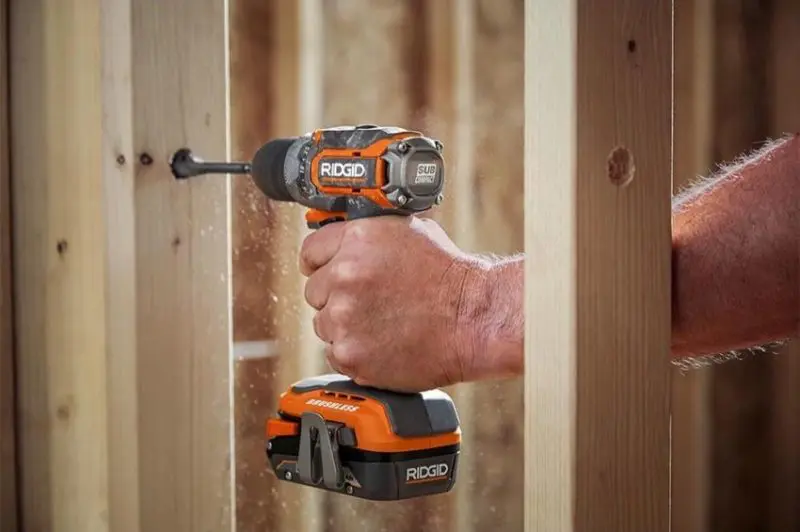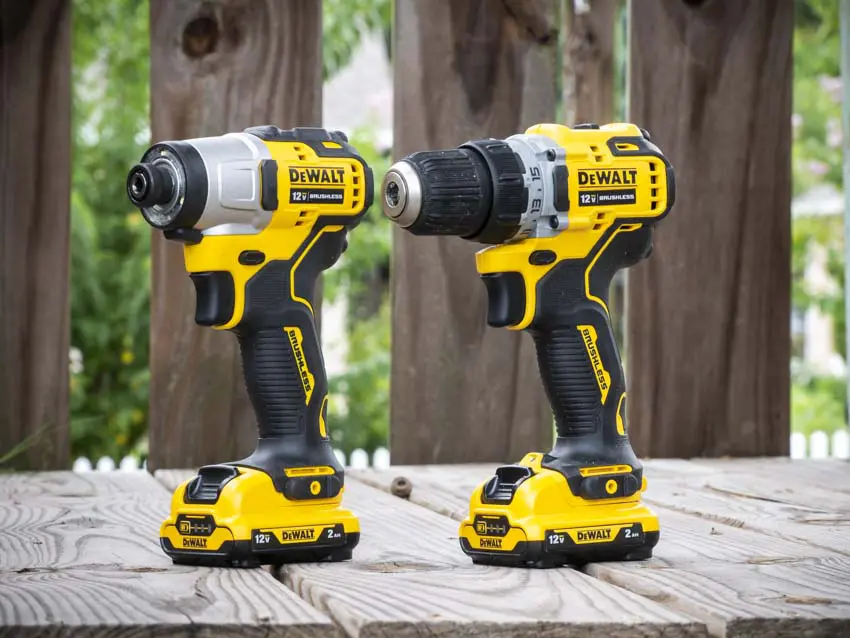It used to be so easy—drills took care of holes and that was that. Now impact drivers give me one more option for making holes or fastening. More than a few folks have asked me over the years about the difference between an impact driver vs a drill. In reality, how and when you use an impact driver vs drill matters. The big deal is that these tools feature different mechanisms to drill and drive fasteners and bits. They also favor different applications. Using each tool properly yields the greatest amount of efficiency. That’s why you typically see Pros carrying both types of tools.
I can give you the basic answers as well as some in-depth perspective on what you need to know as a more advanced tool user. This can be helpful if you want to know whether you should buy that two-tool combo kit or just start out with a basic drill. I’ll cover how manufacturers make these tools as well as how they differ from each other. That should help you decide for yourself when to use each.
At the very least I can help you sound like you know what you’re talking about when the next tool deals arrive at Acme Tools, Home Depot, or Lowe’s!
Impact Driver vs Drill Basics
Simply enough, a drill spins the chuck at the front of the drill. Most cordless drills feature a keyless chuck. That means you don’t need that funny-looking key that’s bent to 90 degrees to change out bits. To use a keyless drill chuck, simply grab it and twist one way to loosen and the other to tighten. Ratcheting chucks in particular are strong enough to hold onto just about any shape that fits into it, including smooth drill bits.
Many drills have multiple speed settings and torque settings. The exact uses for those can be saved for a later discussion since we really just want to understand the major differences for now.

Impact drivers work in a similar way to a drill in that they spin the bit that you have attached. When using a drill to drive a large fastener, you may encounter a point where the drill can’t continue. It’s using all of its power and torque, but it just can’t budge the large fastener or bolt. That’s where the impact driver comes in.
They provide a whole lot more torque.
Use Impact Drivers When You Need More Torque
Imagine working on a stuck bolt. It’s too difficult to loosen with a wrench. You lean on it and pull on it—but you still can’t budge it. To knock it loose, you finally decide to take a hammer and hit the handle of the wrench. That delivers extra, but short-lived, torque.
That’s kind of what an impact driver does.
But it can do it several thousand times per minute!

When it gets to the point that it is stuck, a mechanism inside automatically starts “hitting” the chuck to continue driving the screw or tightening/loosening the bolt.
The impact driver is much stronger than a drill in terms of the way it can deliver that extra torque to break loose stuck bolts and screws or drive them deeper into the material.

Drills Offer More Speed for Fasteners…at a Price
Since an impact driver mechanism repeats a cycle of the anvil driving the rotation of the chuck, it loses efficiency. Drills apply a constant force to the chuck, driving the fastener without stopping or pulsing. As a result, impact drivers, while giving you more torque, tend to drive fasteners a little more slowly.
I’ve seen this over and over again in Pro Tool Reviews drill vs impact head-to-head comparisons. A capable drill will sink a ledger screw faster than an impact driver every time…almost. The exception comes when the torque required exceeds the power of the drill to maintain its optimal speed. When that happens, the drill slows down while the impact driver keeps driving the fastener into the material.
Impact Driver vs Drill Chucks
Impact drivers use a 1/4″ quick-lock hex chuck. These let you slip a hex bit in—and some automatically lock the bit in place. Other lesser designs require you to pull out the flange to insert the bit. To remove it, you again pull the chuck out, and it releases the bit.
One advantage to this system is that it makes for a more compact design to help you get into tighter spaces. The downside is that it requires a hex bit. Your round drill bits won’t fit in the hex chucks of an impact driver.

Until recently, if you wanted to drill a hole, you had to use a drill. Companies like Milwaukee, Ridgid, and DeWalt now offer drill bits that fit impact drivers. There is a push in the industry to allow you to use an impact driver for everything that a drill can do. Be careful though! Impact drivers have a lot more torque than drills and some applications recommend the use of impact-rated bits, not just the standard ones that came in that big kit for $19.99 at Christmas time.

Many impact drivers on the market are single-speed. However, as accessories are being made to include more drilling functions, some companies are offering impact drivers with multiple speed and torque settings.
What about Hammer Drills?
Hammer drills start with a traditional drilling action and have the same kind of chuck as the drill. Most let you switch between drill and hammer drill modes. Like a drill, the hammer drill can also have multiple speeds. Instead of having that hitting action working in the same direction that the chuck spins like the impact driver, the hammer drill works by spinning the bit and “hitting” the bit forward the same way a hammer would deliver its force. Imagine using a drill and rapidly tapping the back of it with a hammer while you use it.
Hammer drills tend to do the best when working in concrete, masonry, stone, and other similar materials. There really isn’t a benefit to using the hammering action to drive into wood or drywall. In fact, the hammering action can often damage those softer materials. All hammer drills work with the hammering mechanism turned off when drilling into materials that don’t need it.

When to Use a Drill, Impact Driver, or Hammer Drill
Use a Drill When
- Driving screws into wood, drywall, and other soft material
- Tightening/loosening bolts that don’t require an extreme amount of torque
- Drilling holes in wood, drywall, and other soft materials
Use an Impact Driver When
- Driving screws into wood or metal (you can use it for drywall if you’ve got a lower speed/torque option)
- Driving large diameter screws or lag bolts
- Tightening/loosening bolts, including those that should be very tight or have been stuck
- Drilling holes in wood, drywall, or metal using new drill bits designed for impact drivers
Use a Hammer Drill When
- Drilling holes in concrete, masonry, or stone (in hammer drill mode)
- Driving screws into wood, drywall, and other soft material (in drill-only mode)
- Tightening/loosening bolts (in drill-only mode)
- Drilling holes in wood, drywall, and other soft materials (in drill-only mode)
Should I Buy a Drill, Impact Driver, or Hammer Drill?
This is a tough question to answer since there are so many different needs out there. If you are only going to buy one product, I’d go with the impact driver. New bits allow you to do everything with it that you can do with a traditional drill. You’re only missing out on the hammering action that optimizes drilling in concrete or masonry materials.
If you can afford to buy a two-tool kit and know (or think) you might need to drill into concrete or stone, go with an impact driver/hammer drill kit. Even without the special bits, the hammer drill should have a drill-only mode that allows it to operate exactly like a drill, and then you’ll also have the impact driver for when you need more torque with nuts/bolts and lag bolts. If you’re not going to be around those masonry applications, stick with a drill/impact driver kit.
Can I Use an Impact Driver as a Drill?
While you can’t do everything with an impact driver that you can with a drill, the two tools can handle similar tasks. If you don’t have a hammer drill, you can certainly use an impact driver for drilling — even drilling into concrete.
There’s a caveat, though. The impacting action of an impact driver tends to leave a rougher finish around the hole. If you’re not going to see the hole once your project is complete, it’s no big deal.
The list of times you can’t use an impact driver as a drill is longer than those times you can. Drill bits such as hole saws, auger bits, and self-feed bits need a beefier shank because of the force they’re under while drilling. You won’t find those types of bits with the 1/4-inch hex shank an impact driver uses.
Quick Reference Chart
Here’s a handy chart you can use to determine if drilling with your impact driver is a viable option.
| Definitely | It’ll Work | Avoid | |
|---|---|---|---|
| Plywood | ✓ | ||
| 2x Lumber | ✓ | ||
| 4x Lumber | ✓ | ||
| Fiberglass | ✓ | ||
| Concrete | ✓ | ||
| Brick | ✓ | ||
| Stone | ✓ | ||
| Tile | ✓ | ||
| Glass | ✓ | ||
| Sheet Metal | ✓ | ||
| Structural Metal <1/8-inch | ✓ | ||
| Structural Metal >1/8-inch | ✓ | ||
| PVC | ✓ |
Impact Drivers vs Drills in Real-World Applications
I’ve had the chance to use these tools on several recent projects. For example, I helped build a wheelchair ramp with a local church. For drilling pilot holes and driving screws, a drill was all we needed. So for projects like building a deck or putting up a wood fence, the drill is a fine choice.
I had to anchor the ramp to concrete on the end, so I used a hammer drill to make the holes before using it to drive the Tapcons in place. When you need to drill a smaller hole in concrete a hammer drill makes the best tool. Large holes are usually done with a tool called a rotary hammer.
Surprisingly, impact drivers do very well making smaller holes in concrete when using multi-purpose bits. I’d limit their use to holes with diameters less than 3/8-inch.
I recently put together a grill and used my impact driver to ensure each connection was very tight. Mechanics will often use impact drivers to tighten and loosen bolts on an engine. A lot of gas engine machinery like mowers and trimmers will require the use of an impact driver (or impact wrench) to tighten and loosen bolts appropriately. Anytime you’re using bolts on metal or driving a screw into metal, you’re going to want an impact tool.
My Personal Preference
For the most part, the impact driver is my go-to tool. I personally keep both a hammer drill and impact driver on hand that meets all of my needs for drilling and driving.
Related Content
- How Does an Impact Driver Work?
- Impact Driver vs Hammer Drill
- Can You Use an Impact Driver as a Drill?
- Best Cordless Drills
- Best Impact Drivers
Follow Pro Tool Reviews on Facebook, Twitter, and Instagram!



